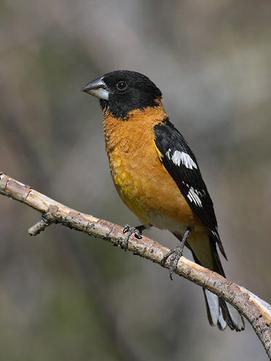BLACK-HEADED GROSBEAK CO-193
Climbing the Rockies: juniper habitat, Temple Canyon Park, Canyon City, Colorado
June 8, 5:06 a.m.
Sunrise at 5:37 a.m.
A black-headed grosbeak at dawn. How unexpected! I didn't know they'd sing like this at dawn. In my subconscious, perhaps a little sleep-deprived, I found it easy to "dismiss" this bird as a robin, but careful listening shows otherwise. It is indeed a black-headed grosbeak in dawn song, slow and deliberate, the slowed delivery a bit like a scarlet tanager or western tanager at dawn, though without the call notes inserted during longish pauses.
Just how slowly is he singing? I measure a few five-phrase groups at random, finding they occur in 4.1, 3.4, 4.0, 3.5, 3.7, 4.1, 4.2 seconds; I take the middle value of 4.0 seconds, calculating that 5 phases per 4.0 seconds is 1.2 phrases per second.
How does that compare to daytime singing? I check out daytime recording CO-198 and take a few measurements: five phrases occur in 2.3, 2.1, 2.4, 2.4, 2.2, 2.3, and 2.3 seconds. The middle value is 2.3 seconds, and I calculate that 5 phrases per 2.3 seconds is 2.2 phrases per second, a rate of delivery 75% faster than at dawn. The difference is striking.
I listen for unique song phrases, but nothing feels obvious until I hear the triple note at 4:12, and then I hear it again at 8:16, 9:00, and 10:08, only four times in this ten and a half minute performance. Given how seldom that note occurs, that probably means that he has a lot of different song notes that he can sing. Test your ears (or eyes in Raven-lite) to determine if you can find how often he repeats some other song notes.
Background
Spotted towhee, common poorwill (poor-will, after 6:17 especially), gray flycatcher, a second black-headed grosbeak, and an occasional burst of wind.

Photo by Robert Royse
